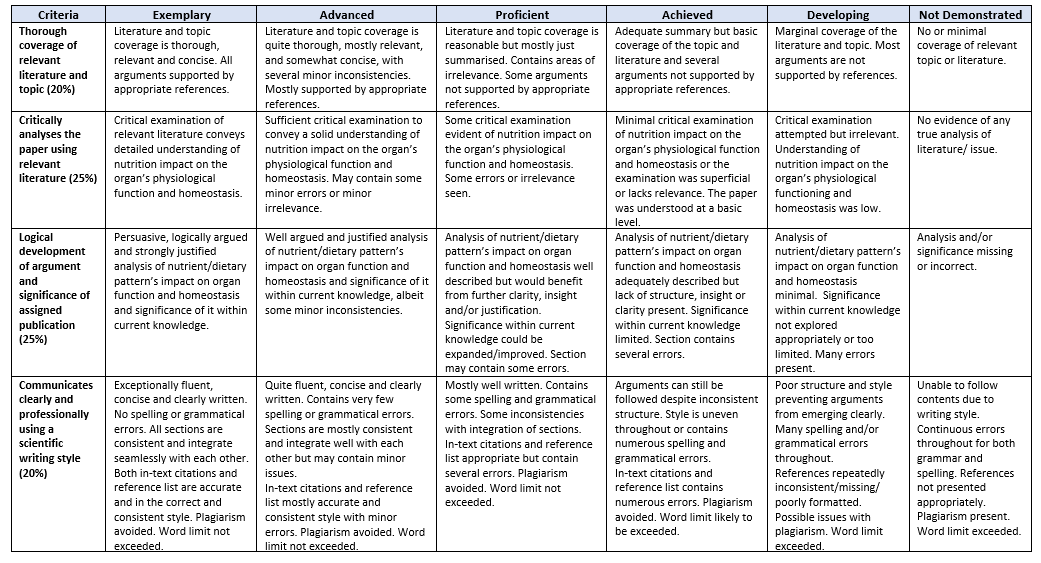Assignment: Controlled Nutritional Study on Energy Excretion and Its Impact on Large Intestine Physiology
| University | University College Cork (UCC) |
| Subject | Nutrition Physiology |
Critical Review of Nutritional Study
The critique should be a balanced discussion and evaluation of the study’s strengths, weaknesses, and notable features. Remember to base your discussion on specific criteria. Your critique should cite (aka reference) and include information from other published research to support your position. Papers cited within the assigned paper do not count for this aspect. Remember to reflect critically here on the impact of nutrient or dietary patterns on the organ’s (large intestine) physiological function and homeostasis.
You can choose how this part is constructed, but here are some examples to get started:
- Most important to least essential conclusions that you make about the article.
- If your critique is more positive than negative, present the negative points first and the positive last.
- If your critique is more negative than positive, present the positive points first and then the negative last.
- If there are strengths and weaknesses, you need to decide your overall judgment.
- You can separate positive and negative points for each main finding.
- You can also include recommendations on improving the article.
(a) Strengths of the Study (approx. 200–250 words)
- Controlled setting – Took place in a monitored room for 3 days to closely track food intake and activity.
- Clear method – Dye-labelled meal bars were used to measure energy loss accurately and keep food intake the same for all participants. Different coloured dyes were used on different days to track the feces clearly, which helped avoid mistakes.
- Advanced methodology – Used tools like bomb calorimetry, body composition scans, and fitness tests to obtain accurate information about the participants’ bodies and energy use (bioelectrical impedance analysis and VO₂max testing).
(b) Recommendations (approx. 150 words)
- Using a more precise method, such as indirect calorimetry, rather than relying on the Harris-Benedict equation, would have enhanced the accuracy of the findings.
- Larger sample size
Are You Searching Answer of this Question? Request Ireland Writers to Write a plagiarism Free Copy for You.
(c) Evaluation of findings/conclusions (approx. 150 words)
- Do the results make sense?
- Are the conclusions backed up by good evidence?
- Are they important or meaningful for real-world use?
- Can we fully trust or apply these results to everyone or every situation?
Weaknesses & Limitations of the study
The study included only 12 young, healthy adults with a normal BMI (18–25 kg/m²). Therefore, the sample is not representative of the general population, and the findings cannot be extrapolated to broader groups (Gumpili and Das, 2022), including individuals with obesity, gastrointestinal disorders, or metabolic conditions, whose energy excretion patterns may differ. For instance, Basolo et al. (2020) found higher stool calorie loss during underfeeding (8.9 ± 3.7%) compared to overfeeding (5.8 ± 1.9%) and during vancomycin treatment (260.1 ± 66.5 kcal/day) versus placebo (176.8 ± 79.5 kcal/day). This limits the applicability of Bao et al.’s (2025) findings to clinical or at-risk populations with various physiological and metabolic profiles affecting energy excretion.
The study’s short three-day duration, with energy excretion assessed over 24 hours, may not reflect natural day-to-day variability. Studies have shown that faecal energy excretion varies day-to-day and is affected by physiological conditions and environmental factors (Theodorakis and Nikolaou, 2025; Lund, Gerhart-Hines, and Clemmensen, 2020; Rose et al., 2015). Procházková et al. (2024) found notable daily fluctuations in gut microbiota, stool moisture, and fecal pH over nine days, highlighting the need for extended study periods to capture such variations.
Total energy requirements were estimated using the Harris-Benedict equation, which ESPEN notes can be inaccurate, especially in clinical scenarios such as overfeeding or underfeeding (Berger et al., 2024). A study highlighted that relative faecal energy loss was, on average, ~6% during overfeeding and rose to ~9% during underfeeding, emphasising the potential inaccuracy of predictive equations like Harris–Benedict in calculating energy needs when energy excretion fluctuates (Bao et al., 2022)..
AT3 Review Rubric

Get Solution of this Assessment. Hire Experts to solve this assignment for you Before Deadline.
Are you having difficulty writing your Nutrition Physiology assignment? Now you don’t have to worry. We provide Ireland Assignment Help AI-free and can solve your problem with our experts, who are available to help you with 100% original content. Just write do my assignment. And our platform also provides you with free sample assignments where you can see the quality of our service. Contact us right now! And take your grades to the next level.

